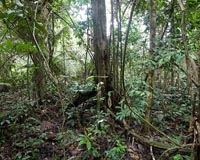 |
Rio De Janeiro (AFP) Dec 29, 2010 The police operation is carried out with the precision of a military ambush: a dozen officers in camouflage leap from a truck and quickly take control of the blackmarket alleyways in a northern Rio suburb. Within minutes, their human targets are rounded up -- along with the "hostages" they are holding: birds, turtles, monkeys and reptiles. This is Brazil's war on animal smugglers, a fight against the raiders of the flora and fauna of Latin America's most bio-rich nation. It's a fight authorities say they are winning. "Thanks to checks, we have cut the traffic in exotic animals on the market by 80 percent compared to last year," Lieutenant Marcele Figueiredo, a 28-year-old woman commanding Rio's special environmental police battalion, told AFP. Created in 1983, the battalion counts 400 officers, six of them female. And it has no time to rest. Each year in Brazil, 250,000 animals are grabbed and stuffed in bags or cages for sale, according to official statistics. Animal trafficking ranks as the third most lucrative criminal activity in Brazil, after the sale of arms and drugs, police say. It generates a billion dollars a year, according to an association called Renctas which is dedicated to fighting the trade. Under Brazilian law, hunting and keeping in captivity any wild animal is prohibited except on a few rare farms with special authorization. But blackmarketeers keep an underground trade going, selling a green parrot or a toucan grabbed from its habitat for prices 10 percent those being asked in legal shops. "That price difference is what keeps the trafficking going," Figueiredo said. Every species is prey for Brazil's poachers. Birds are most often sold, going for 10 dollars for an ordinary breed to up to 10,000 dollars for a Hyacinth Macaw, a beautiful blue parrot prized as pets. The more endangered the animal, the higher its price. Around 40 percent of the trafficked animals are headed for Europe or North America. Brazilian buyers, though, also fuel the activity. One man arrested for trying to sell a green parrot for the equivalent of a few dollars claimed he did not know he was breaking the law. "I just wanted to get rid of it because it bites," he said, before receiving a fine and being released on a promise of not offending again. That bird and the other animals seized are taken to a state sorting center close to Rio, where they are put in quarantine. Around 8,000 animals a year arrive in the facility, many of them in pitiful condition. There are a few primates among them -- monkeys abandoned by their owners as they become more aggressive adults. "It's really a problem," one veterinarian at the center said, explaining that the monkeys are unable to fend for themselves if released into the wild. The ones that do make it to the center are the lucky ones. Half the animals smuggled die in transit. "They are transported in awful conditions. They're kept in tiny closed boxes with little air. They go for hours without eating or drinking," said one vet, Daniel Marchesi. "There is a huge diversity of species in Brazil, and some very beautiful animals which people want to own. And it's in the Brazilian culture to have all sorts of exotic animals at home," Marchesi said.
Share This Article With Planet Earth
Related Links Darwin Today At TerraDaily.com
 New species abound in Peru, but so do threats
New species abound in Peru, but so do threatsLima (AFP) Dec 28, 2010 Each year, a new bird is found and every four years a new mammal discovered in the Peruvian Amazon, a haven for biodiversity where conservation and danger often go hand in hand. Although Peru is known for its Andes mountain range, the Amazon actually covers 60 percent of the country's territory. It is a hotbed of bio-activity and is home to 25,000 species of plants - 10 percent of the world ... read more |
|
| The content herein, unless otherwise known to be public domain, are Copyright 1995-2010 - SpaceDaily. AFP and UPI Wire Stories are copyright Agence France-Presse and United Press International. ESA Portal Reports are copyright European Space Agency. All NASA sourced material is public domain. Additional copyrights may apply in whole or part to other bona fide parties. Advertising does not imply endorsement,agreement or approval of any opinions, statements or information provided by SpaceDaily on any Web page published or hosted by SpaceDaily. Privacy Statement |